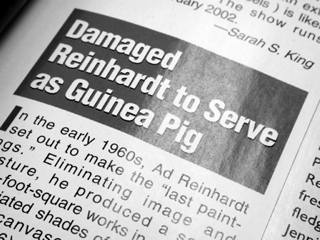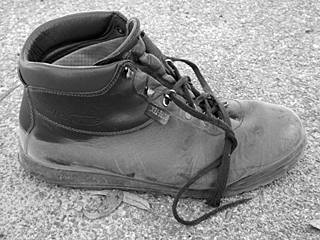| | 
- 30 July 2001
- Damaged Rinehart
- I received quite a surprise when I opened up the June copy of Art in America and saw the headline, Damaged Rinehart to Serve as Guinea Pig.
Yikes! I guess Rainier Ail may not be as benign as scientists claim. Why didn’t anyone tell me about my future as a guinea pig before? And what kind of experiments are in store for me? Optimist that I am, perhaps the research involves something pleasant, such as the restorative effects of Bunnahabhain on a damaged Rinehart. I was just starting to imagine the myriad implications of my role as a guinea pig when I noticed a critical piece of the puzzle I’d overlooked before. It turns out the piece was about Ad Reinhardt, not me. I should have known. Everyone is forever confusing Ad and me; that’s one of the reasons I avoid large parties. What the nefarious researchers are going to do with a painter who died in 1967, this I do not want to know. 
- 31 July 2001
- Never Answer an Anonymous Letter
- I told Cindy I received an unsigned bit of correspondence from someone who chastised me for a litany of “perverted perversions, sick depredations, obscene acts unspeakable, and a bad attitude as well.”
“A friend?” Cindy asked. “It does sound like someone I know,” I admitted, “but none of my friends are shy enough to resort to an unsigned letter.” “I’d wager you’re going to reply with one of your stupid vitriolic diatribes,” Cindy suggested. “Bad bet, sweetie,” I replied. “In times like this I always ask myself the obvious question: ‘what would Yogi Berra do in this situation?’” “Punch line, David,” Cindy demanded. “Never answer an anonymous letter.” 
- 1 August 2001
- Drinking to Stupidity
- I told Keith I was headed back to San Francisco on Friday, and suggested that we enjoy a going-away drink.
“I think that would be prudent,” Keith agreed. “After all, a journey of a thousand miles in someone else’s moccasins starts with a single beer.” “I’ve never heard that phrase before,” I replied. “I just made it up,” Keith admitted with a stupid grin. Stupidity: I’ll drink to that! 
- 2 August 2001
- Duchampian Deoxyribonucleic Acid Triumphant
- In 1946, Marcel Duchamp inscribed one of his Boîte-en-Valise collections to the sculptor Maria Martins. Duchamp was evidently quite smitten, and who wouldn’t be? According to Maria’s daughter Nora, “My mother could seduce anybody.” (One of the purported secrets of her technique was her unusual chat-up line: “I like you very much. Tell me who your enemies are, so that I can help you hate them.”)
Love is never simple, especially when there’s a third person involved. In this case, that third person was Carlos Martins, the Brazilian ambassador to the United States, who also happened to be married to Maria. Duchamp included a unique piece, Paysage fautif (Faulty Landscape), in the Boîte-en-Valise collection he gave Maria. Paysage fautif is a blobby abstract on celluloid backed with black velvet. At first glance, it seemed very retinal, very un-Duchampian. But, as David Hockney wisely observed, “It’s not in the spirit of Duchamp to be Duchampian.” Scientists have determined that Paysage fautif is yet another of Duchamp’s pieces that takes decades to reach maturity. Although I generally ignore scientists when they attempt to shed light on aesthetics with rigorous proof, I had to admit that science did serve art when lab technicians concluded from the DNA evidence that Duchamp’s medium of choice for Paysage fautif was his own sperm. I think the idea of a love letter that can be read for the first time twice—with half a century and a couple deaths in-between—is a beautiful idea. 
- 3 August 2001
- Greenland Standoff
- Oh dear, I’m in a standoff over Greenland. Normally, such a standoff in this region would be resolved with a hakapick, but there don’t seem to be any on this 747. Here’s the situation ...
I asked the KLM flight attendant for two beers, a bottle of whisky, and a bottle of red wine “for me and my friends.” “I’m shorry, shir,” the pasty Dutchman replied, “but you would not appear to be in shuch a need.” “I beg your pardon,” I said indignantly, “but is that any way to treat a valued passenger?” “You, shir, are not a ‘valued pashenger,’ the surly servant brusquely informed me. “Kinky Love Motion’s valued passhengersh are in our firsht-clash cabin.” “Well if I’m not a valued passenger,” I asked, “then what am I?” “You, shir,” the young man replied, “are, in technical aeronautic termsh, ‘shelf-loading cargo.’” Were it not for my hip flask, I’d have been outmaneuvered by the swarthy Dutch. Damnation! 
- 4 August 2001
- The M2A Swallowable Imaging Device
- Given Imaging Ltd. has developed a camera in a pill, the enigmatically-named M2A Swallowable Imaging Device. Here’s how it works. After a patient swallows the M2A Swallowable Imaging Device, the camera beams images to a receiver on a wristband. The doctor may then watch pictures of the patient’s innards on a computer monitor.
What a waste! Although I’m sure someone suffering from an intestinal malady might appreciate a doctor’s ability to view abnormalities without sticking one of those tuby-proby things down their throat, I think such pedestrian uses of such a promising new technology is, well, rather pedestrian. After all, almost every television station broadcasts nothing but feces. Instead, I’d like to use the M2A Swallowable Imaging Device for aesthetic purposes. For example, wouldn’t it be perfect to end a documentary on, say, Lola the Lamb, with a closing scene showing most of her leg being devoured by a drunk at a wedding? And with the M2A Swallowable Imaging Device, the story wouldn’t end there, absolutely not! With the M2A Swallowable Imaging Device, we could follow Lola’s last hours as she passed through the drunk’s gastrointestinal tract. With just a bit of digital editing, we could see part of Lola’s leg learn to surf on a raging river of booze. I’m sure that the M2A Swallowable Imaging Device offers myriad other aesthetic possibilities, but at the moment, I’m so smitten with Lola’s leg that I can’t think of anything else. I will, however, address the obvious question. Yes, the camera is disposable. 
- 5 August 2001
- Quantity Equals Quality
- My learned friends are decrying the state of Chinese restaurants. They complain that crude Western palates do not appreciate the unfamiliar Chinese cuisine, and thus all too many Chinese restaurateurs are forced to use the buffet business plan, offering diners “all you can eat” for a fixed, very low price. My friends believe that since “all you can eat” usually translates into “as much food as you can stuff down your gullet without vomiting,” the emphasis is on quantity, not quality.
I disagreed. When it comes to food, I think the largest quantity is almost always the best quality. I feel sorry for all my rich friends who spend a fortune on a meal in an expensive restaurant and only get a sliver of salmon, a dozen peas, and a sprig of radicchio. My taste, or perhaps lack of same, may be biological. I remember my late father’s serious review of hospital cuisine: it tasted bad, and the portions were small. Like father, like son? 

- 6 August 2001
- California Dust
- There’s at least one thing wrong with hiking in California, and that thing is dust. And lots of it. Although the state has a few moist spots here and there, it seems that most places are covered in a thin layer of fine dust. As a result, California hikers generally end the day covered in the same fine dust.
I was reminded about the dusty situation when I saw my boots after a relatively short hike. The tops of the boots, which were covered by my pants, were clean. The lower parts were coated in a thick haze of dust. I prefer dusty boots to footwear covered in English mud and sheep feces, but that comparison doesn’t provide much satisfaction at the end of a dusty day. Ideally, hiking boots should end a happy walk mildly damp, with perhaps a few pine needles here and there. It looks like I’ll need to head north of California for such an ideal hike, so I shall. 
last weak | index | next weak
©2001 David Glenn Rinehart
| |

